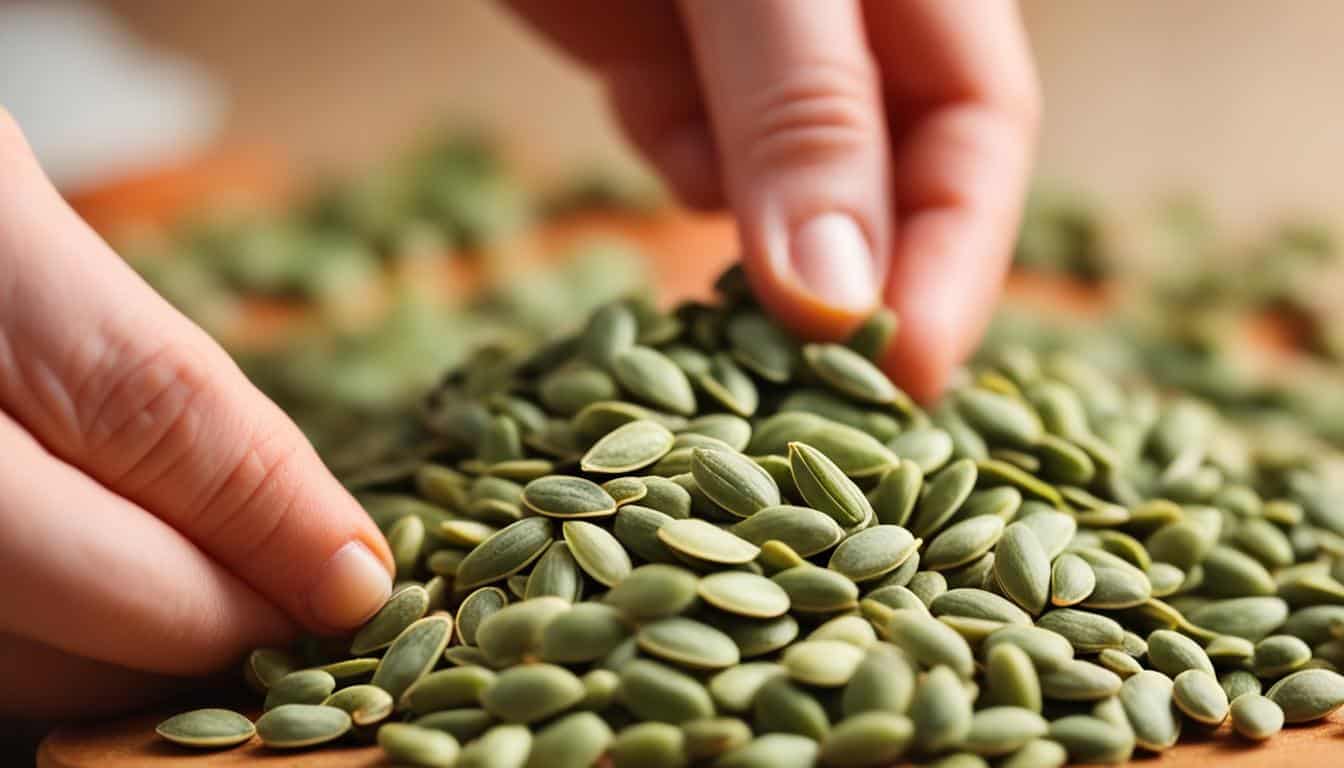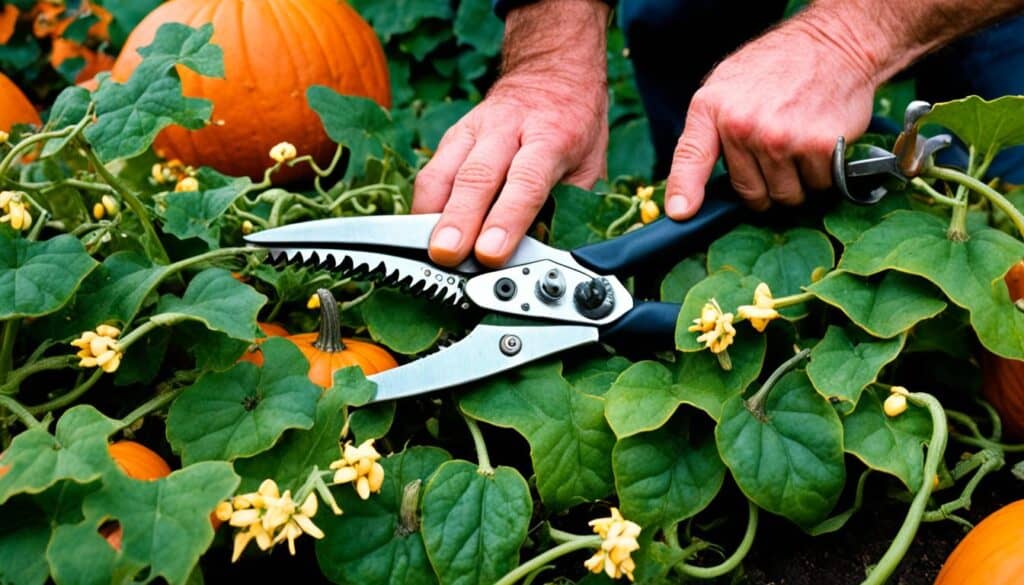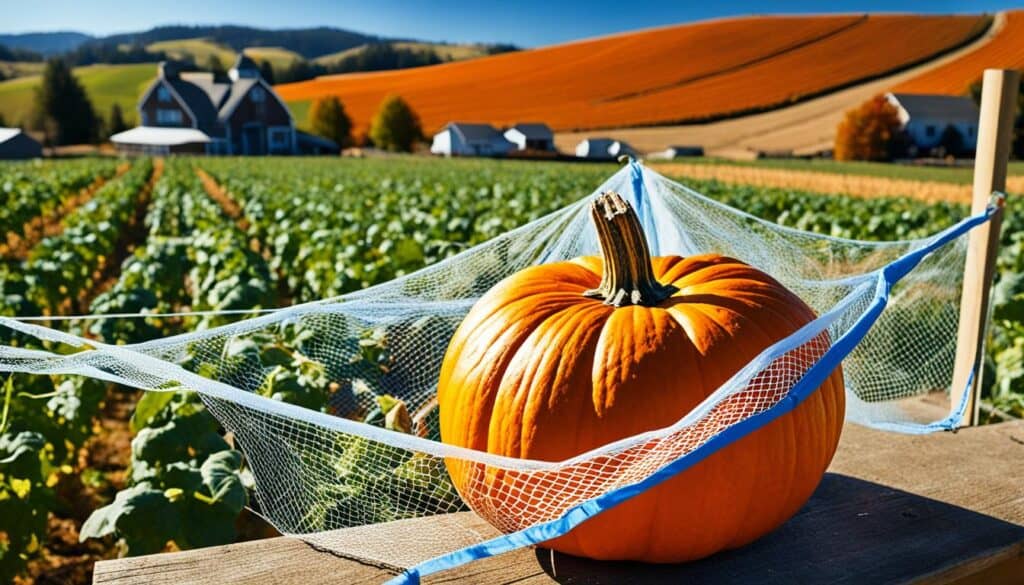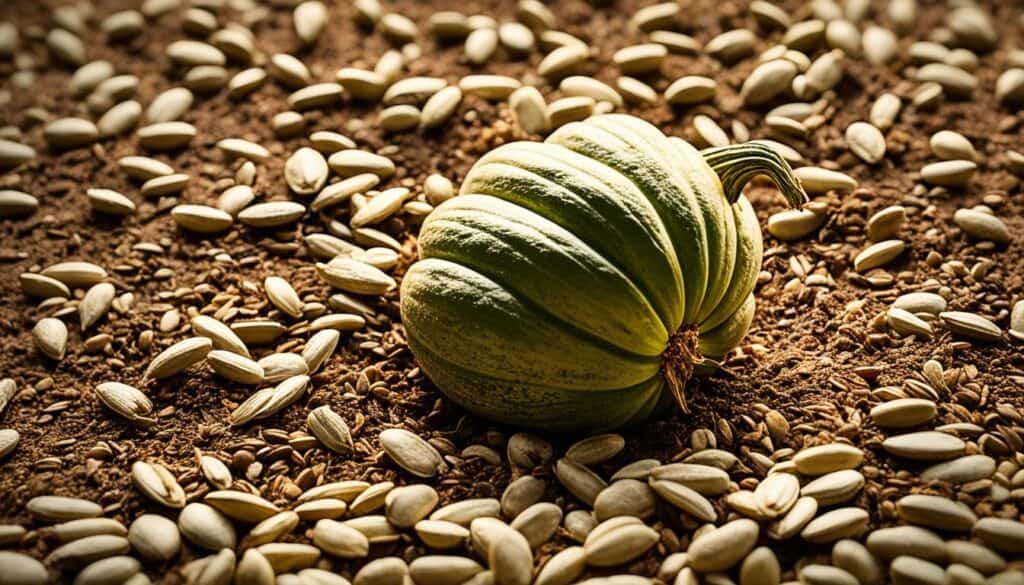Did you know that the world record for the largest pumpkin ever recorded is a whopping 2,624 pounds? That’s equivalent to the weight of a small car! Growing giant pumpkins has become a fascinating hobby for many gardening enthusiasts, and with the right knowledge and techniques, you too can achieve impressive results.
Key Takeaways:
- Choose the right variety of giant pumpkin seeds, such as ‘Dill’s Atlantic Giant’, known for producing massive pumpkins.
- Prepare the soil properly by tilling, adding composted manure, and adjusting the pH if necessary.
- Start the seeds indoors before transplanting them into the prepared bed for a head start on growth.
- Care for your pumpkin plant by providing regular watering, fertilization, and vigilance against pests and diseases.
- Prune and train the vine to encourage the growth of a single large pumpkin, and protect it from rot and insect damage.
Now, let’s dive into the secrets of growing giant pumpkins and uncover the tips and tricks that will help you grow your own record-breaking pumpkin!
Selecting the Right Variety
The key to growing a massive pumpkin lies in selecting the right variety. One of the most popular giant pumpkin varieties is ‘Dill’s Atlantic Giant’. These seeds are well-known for producing pumpkins that can reach weights of 200 to 300 pounds. While there are other giant pumpkin varieties available, most competition-size pumpkins come from this particular variety.
To ensure you get the best seeds, it’s important to order them from a reliable mail-order nursery. This guarantees that you are getting high-quality seeds that will give you the best chance of growing a giant pumpkin. Here is a comparison of some common giant pumpkin varieties:
| Variety | Average Weight | Description |
|---|---|---|
| ‘Dill’s Atlantic Giant’ | 200-300 pounds | A popular variety known for producing large and heavy pumpkins. |
| ‘Prizewinner’ | 150-200 pounds | A slightly smaller variety but still capable of producing impressive pumpkins. |
| ‘Big Max’ | 100-150 pounds | A good choice for beginners, as it is easier to manage compared to larger varieties. |
When selecting your seeds, it’s important to consider your goals and level of experience. If you’re aiming for a record-breaking pumpkin, opt for a high-pedigree hybrid seed like ‘Dill’s Atlantic Giant’. These seeds may be more expensive, but the potential for growing a massive pumpkin makes it worth the investment. However, if you’re a beginner or simply want to enjoy growing a large pumpkin without the pressure of competition, a variety like ‘Big Max’ might be a better choice.
Ultimately, the variety you choose will play a significant role in the size and quality of your pumpkin. Take the time to research different giant pumpkin varieties and choose the one that best aligns with your goals and gardening abilities.
Preparing the Soil
To grow a giant pumpkin, proper soil preparation is crucial. The right soil conditions provide the foundation for healthy growth and maximum yield. Here’s how to prepare your soil for giant pumpkin cultivation.
Choosing the Right Location
Start by selecting a sunny area for your pumpkin patch. Giant pumpkins need at least 6 to 8 hours of direct sunlight each day to thrive. Aim for a minimum of 1,200 square feet of space, which is roughly equivalent to a 40-foot diameter circle. This ample space allows your pumpkin vines to spread out and ensures adequate air circulation.
Tilling and Amending the Soil
Before planting, prepare the soil by tilling it thoroughly. This helps to loosen the soil and create a favorable environment for the pumpkin roots to grow. Once the soil is tilled, spread a layer of composted manure over the entire bed. Aim for a depth of about 6 inches. Composted manure provides essential nutrients and improves soil structure.
Paying Attention to Soil pH
A proper soil pH is essential for optimal pumpkin growth. The ideal pH range for giant pumpkins is between 6.0 and 6.8. To determine the pH of your soil, it’s a good idea to perform a soil test. Soil testing kits can be purchased from gardening centers or online. If the pH is too low, you can raise it by adding lime. On the other hand, if the pH is too high, sulfur can be used to lower it.
Mounding and Mulching
After tilling and amending the soil, shape the bed into a low broad mound. Mounding provides better drainage and ensures that excess water doesn’t accumulate around the pumpkin roots. To protect the soil during the winter, cover the bed with a layer of straw mulch. Mulching helps to retain moisture, control weeds, and insulate the soil from temperature fluctuations.
Soil Preparation Steps
| Step | Description |
|---|---|
| 1 | Choose a sunny location with at least 1,200 square feet of space. |
| 2 | Till the soil thoroughly to loosen it and improve aeration. |
| 3 | Spread a 6-inch layer of composted manure over the bed. |
| 4 | Test the soil pH and adjust if necessary. |
| 5 | Shape the bed into a low broad mound for improved drainage. |
| 6 | Cover the bed with straw mulch to protect it during winter. |
By following these soil preparation techniques, you can create an optimal environment for growing giant pumpkins. With the right soil conditions, your pumpkins will have the best chance of reaching impressive sizes.
Starting the Seeds Indoors
For a head start on growing giant pumpkins, I recommend starting the seeds indoors about a month before the average last frost date. This allows the plants to establish and develop a strong root system before being transplanted into the garden. Indoor seed starting is a simple and effective way to ensure successful germination and early growth.
To start the giant pumpkin seeds indoors, plant them in peat pots filled with high-quality seed starting mix. The peat pots provide a biodegradable container that can be planted directly into the ground without disturbing the delicate root system.
When it comes to germination temperatures, giant pumpkin seeds thrive in temperatures between 65° to 75°F (18° to 24°C). Maintaining a consistent temperature within this range is crucial for successful germination. Using a seedling heat mat can help maintain the ideal temperature, promoting faster and more uniform germination.
During the germination period, it’s essential to keep the soil evenly moist but not waterlogged. Overwatering can lead to fungal diseases and poor root development. As the seedlings emerge, provide them with ample light to encourage healthy growth. Placing them near a sunny window or using fluorescent grow lights for at least 14-16 hours a day will ensure they receive adequate light.
Once the seedlings have developed several true leaves, they can be transplanted into larger containers or directly into the prepared garden bed. Ensure that all chance of frost has passed before transplanting the seedlings outdoors, as they are still susceptible to cold temperatures.
Starting giant pumpkin seeds indoors allows you to prolong the growing season and gives your plants a much-needed head start. By providing the ideal conditions for germination and early growth, you are setting the foundation for healthy and robust pumpkin plants that will continue to thrive as they transition to the garden.
Caring for Your Pumpkin Plant
Growing a giant pumpkin requires regular care and attention. Taking care of your pumpkin plant throughout its growth cycle will help ensure a healthy and bountiful harvest. Here are a few essential tips for pumpkin plant care:
Watering Giant Pumpkins
Water is crucial for the growth and development of your pumpkin plant. It’s important to water your giant pumpkins consistently and adequately. Aim to keep the soil consistently moist, but avoid overwatering, as this can lead to root rot and other problems.
Tip: To determine if your plants need watering, insert your finger into the soil about an inch deep. If it feels dry, it’s time to water.
Fertilizing Pumpkins
Regular fertilization is essential for the healthy growth of your pumpkin plants. Every two weeks, apply a balanced fertilizer specifically formulated for vegetables or pumpkins. Alternatively, you can use decomposed manure or compost to provide the necessary nutrients.
Preventing Pests and Diseases
Pests and diseases can significantly impact the health and productivity of your pumpkin plants. Regularly inspect your plants for signs of pests such as aphids, squash bugs, or powdery mildew. If you notice any issues, promptly apply appropriate treatments or natural remedies to prevent further damage.
Tip: Planting marigolds or other companion plants near your pumpkin plants can help deter pests.
To help you visualize the key points for caring for your pumpkin plant, here is a helpful table summarizing the care requirements:
| Care Aspect | Recommendation |
|---|---|
| Watering | Keep soil consistently moist but avoid overwatering. |
| Fertilizing | Apply a balanced fertilizer every two weeks or use compost. |
| Pest and Disease Prevention | Regularly inspect plants for pests and diseases and take appropriate action. |
Pruning and Training the Vine
Pruning and training the pumpkin vine is a crucial step in cultivating a single large pumpkin. By following the right techniques, you can maximize the growth potential and yield of your pumpkin plant.
Removing Flower Buds
When the vine reaches a length of around 10 feet, it’s time to start pruning. Remove any flower buds that appear on the vine until it reaches the desired length. This allows the plant to focus its energy on vine growth rather than fruit development in the early stages.
Allowing Selective Development
Once the vine has reached the desired length, you can allow several flowers to develop into pumpkins. However, to ensure the growth of a single large pumpkin, it’s essential to remove all but the largest fruit after several weeks of growth. This directs the plant’s resources toward the chosen pumpkin, promoting its size and quality.
Staking and Burying Leaf Nodes
To protect the vine from wind damage and provide support, it’s advisable to stake down or bury leaf nodes along the vine. By securing the vine and preventing it from being damaged by strong winds, you can ensure the longevity and stability of the plant throughout its growth cycle.
Hand Pollination for Optimal Seed Development
Hand pollination is a technique used to enhance seed development in pumpkin plants. By manually transferring pollen from the male flower to the female flower, you can increase the chances of successful pollination and allow for the production of robust seeds. This can be done by identifying the male flower (with a long stem) and gently rubbing its pollen onto the stigma of the female flower (with a small pumpkin growing behind).
Pruning and training the pumpkin vine not only ensures the growth of a single large pumpkin but also promotes better airflow and overall plant health. Mastering these techniques is key to maximizing your giant pumpkin’s potential and achieving impressive results.
Protecting and Supporting the Pumpkin
As the pumpkin grows, it’s important to take measures to protect it from rot and insect damage. Implementing a few simple strategies can help ensure the health and longevity of your pumpkin crop.
- Place a large piece of cardboard or wood under the fruit to avoid direct contact with the moist earth. This will prevent rot and decay caused by prolonged exposure to damp soil.
- Spread a layer of sand below the pumpkin. This not only helps with moisture control but also creates a barrier between the pumpkin and potential soil-borne pests.
- Add a canopy of shade cloth over the pumpkin. This protective covering shields the pumpkin from excessive sunlight, which can damage the skin and make it more susceptible to rot. The shade cloth also helps regulate temperature and moisture levels, creating an ideal environment for healthy pumpkin growth.
- Regularly inspect the vine for rootlets that form along its length. These rootlets can divert energy away from fruit development. Gently remove any rootlets to encourage larger pumpkins.
- Spread additional soil over areas where new roots are forming along the vine. This promotes a stronger and more extensive root system, providing optimal support for the growing plant.
By implementing these protective measures, you can safeguard your pumpkins from common threats and ensure their successful growth and development.
Harvesting Your Giant Pumpkin
Harvesting a giant pumpkin is an exciting moment. Wait until the end of the season, just before the first frost, to harvest the pumpkin. It should be pale yellow to orange-ish red when it’s ripe. Once harvested, a giant pumpkin can be used for a variety of purposes, such as making soups, pies, and muffins.
Ripe Pumpkin Signs
Knowing when your giant pumpkin is ripe is crucial for a successful harvest. Look for these signs:
- The skin color changes from dark green to a pale yellow or orange-ish red.
- The pumpkin develops a hard outer shell.
- When tapping the pumpkin, it produces a hollow sound.
- The stem starts to dry out.
Using Giant Pumpkins
Giant pumpkins are not only impressive to look at, but they are also incredibly versatile in the kitchen. Here are some creative ways to use your giant pumpkin:
“I love experimenting with my giant pumpkin harvest every year. From soups and stews to pies and muffins, the possibilities are endless!” – Susan, pumpkin enthusiast
| Recipe | Description |
|---|---|
| Pumpkin Soup | Smooth and creamy soup, perfect for chilly autumn evenings. |
| Pumpkin Pie | A classic dessert that showcases the natural sweetness of the pumpkin. |
| Pumpkin Muffins | Moist and flavorful muffins that make a delightful breakfast or snack. |
| Pumpkin Cheesecake | A rich and decadent dessert that combines the flavors of pumpkin and cream cheese. |
With a giant pumpkin, the culinary possibilities are endless. Get creative in the kitchen and enjoy the delicious flavors of your harvest!
Choosing the Right Seeds
To grow a giant pumpkin, it’s crucial to start with the right seeds. High-pedigree hybrid seeds, specifically bred for giant pumpkins, are highly recommended. These seeds are specially developed to produce plants with the potential for impressive size and weight. While they may be pricier compared to regular pumpkin seeds, ranging from $10 to $100 or more per seed, the investment is well worth it for those aiming to grow record-breaking pumpkins.
When selecting giant pumpkin seeds, it’s crucial to consider their pedigree and genetic lineage. High-pedigree hybrid seeds are carefully bred by experienced growers who have perfected the art of growing giant pumpkins. These seeds are the result of years of selective breeding, bringing together the best traits from different varieties to create offspring with exceptional growth potential.
By choosing high-pedigree hybrid seeds, you set yourself up for success right from the start. These seeds ensure that you have a higher chance of producing pumpkins that reach enormous sizes, making them ideal for competitions or simply for the satisfaction of growing something truly extraordinary.
Here is an image of giant pumpkin seeds to help you visualize their appearance:
Now you might be wondering, why are these seeds more expensive? The cost of high-pedigree hybrid seeds reflects the time, care, and expertise invested in their development. Growers meticulously hand-pollinate plants, meticulously selecting parent plants with desirable characteristics year after year, ensuring the best offspring with each generation. This intensive process, combined with limited availability, contributes to the higher price tag.
Benefits of High-Pedigree Hybrid Seeds:
- Increased potential for giant-size pumpkins
- Improved genetics and traits
- Higher chances of success in pumpkin-growing competitions
- Greater satisfaction in growing and showcasing extraordinary pumpkins
While the cost of high-pedigree hybrid seeds may seem high, it’s essential to consider the potential returns. A single giant pumpkin can attract attention, win competitions, and provide a sense of accomplishment. Additionally, giant pumpkins can generate excitement in your community or even media attention, making it a rewarding experience beyond measure.
“By planting high-pedigree hybrid seeds, you give yourself the best chance to grow a giant pumpkin that will turn heads and make a lasting impression.”
Don’t let the cost deter you. Consider it an investment in the pursuit of growing something truly remarkable.
Soil Preparation and Mounding
Proper soil preparation is essential for growing giant pumpkins. To ensure optimal growth and yield, follow these steps to prepare the soil:
- Till the Soil: Start in the fall by tilling the soil to a depth of about 12 inches. This helps loosen compacted soil and improves drainage.
- Add Composted Cow Manure: Mix in a generous amount of composted cow manure. This organic matter enriches the soil with nutrients and improves its texture.
- Shape the Soil into Mounds: Create mounds by forming compact soil structures. Mounds are beneficial because they provide better drainage, warmth, and air circulation to the pumpkin plants.
“Mounds help improve drainage, warmth, and air circulation, creating optimal growing conditions for giant pumpkins.”
In addition to shaping the soil into mounds, consider these additional steps for soil preparation:
- Straw Mulch or Cover Crop: Cover the soil with a layer of straw mulch or plant a cover crop, such as clover, to protect the soil during the winter. This helps prevent erosion and retains moisture in the soil.
- Add Additional Compost: In the spring, top the mounds with another layer of compost. This provides a nutrient boost for the growing pumpkin plants.
By preparing the soil and mounding it properly, you create an ideal environment for your giant pumpkin plants to thrive.
Direct Seeding and Sunlight Requirements
To grow giant pumpkins, direct seeding is the preferred method. It involves sowing the pumpkin seeds directly into the ground, rather than starting them indoors. Direct seeding is best done in warm, frost-free weather, ensuring optimal conditions for seed germination and plant growth.
In addition to direct seeding, providing the right sunlight conditions is crucial for the successful development of pumpkin plants. Pumpkins are sun-loving plants that thrive when they receive ample sunlight. It is recommended to choose a planting area that receives at least 6-8 hours of direct sunlight per day.
With adequate sunlight, the pumpkin plants can produce strong stems and leaves, which are essential for supporting the growth of large pumpkins. Additionally, sunlight aids in the photosynthesis process, enabling the plants to convert light energy into carbohydrates and fuel their growth.
Optimal sunlight exposure ensures that the plants have sufficient energy to produce healthy, large fruits. Lack of sunlight can lead to weak and stunted pumpkin growth.
Sunlight Requirements for Pumpkins
Direct sunlight is crucial for the overall health and productivity of pumpkin plants. Here are a few key points to keep in mind regarding sunlight requirements:
- Pumpkins should receive at least 6-8 hours of direct sunlight per day. This can be achieved by selecting a well-exposed location in your garden.
- Ensure that there are no obstructions, such as buildings or trees, that can cast shadows on the pumpkin plants during peak sunlight hours.
- Periodic repositioning or rotation of the plants can help ensure even sunlight exposure on all sides, promoting uniform growth.
- While pumpkins benefit from ample sunlight, extreme heat can be detrimental. If you live in an area with scorching temperatures, consider providing partial shade during the hottest part of the day to protect the plants from heat stress.
By meeting the sunlight requirements of pumpkins, you can create an optimal growing environment that encourages vigorous growth and the production of large, healthy pumpkins.
Conclusion
Growing giant pumpkins requires careful planning, preparation, and maintenance. Selecting the right variety, preparing the soil, and providing proper care throughout the growing season are key factors in achieving record-breaking pumpkin sizes. With dedication and attention to detail, you can grow your own giant pumpkin that will be the envy of every contest. Good luck!










Leave a Reply